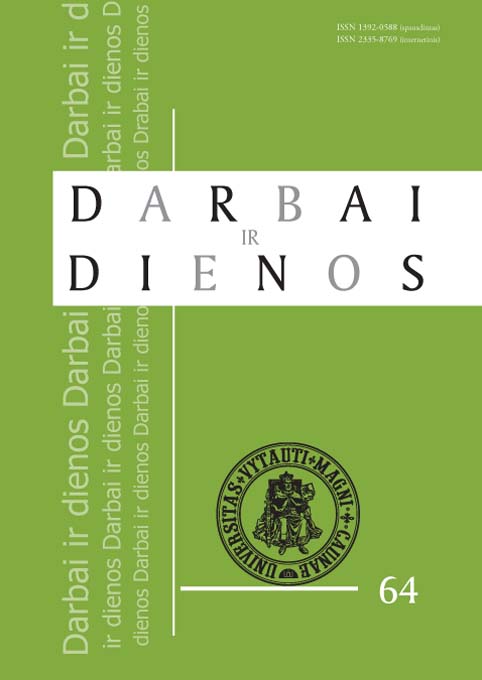LIETUVIŲ KALBOS DAIKTAVARDINIŲ FRAZIŲ ŽODYNO VIENAFORMIAI PASTOVIEJI JUNGINIAI
STABLE MULTI-WORD UNITS IN THE DICTIONARY OF LITHUANIAN NOMINAL PHRASES
Author(s): Erika Rimkutė, Jolanta KovalevskaitėSubject(s): Language and Literature Studies, Theoretical Linguistics, Philology
Published by: Vytauto Didžiojo Universitetas
Keywords: Lithuanian language; Stable multi-word
Summary/Abstract: The source of the research is the database of the Dictionary of the Lithuanian Nominal Phrases, which contains ca 69,000 phrases of varying length from 2 to 16 words. Phrases were extracted by the statistical method of Gravity Counts from the Corpus of the Contemporary Lithuanian Language (100 million running words). The analyzed data contain 3,704 two-word, 3,702 three-word and 870 four-word multi-word units (MWUs), which were detected automatically as being of one particular grammatical form; therefore, in this study, we refer to such MWUs as stable uniform MWUs. The results revealed that among stable uniform MWUs, there are fully fixed expressions (idioms, sayings, compound nominals, etc.). However, the majority of stable MWUs are collocations, which were extracted as one particular grammatical form due to the fact that this particular form had the highest frequency in the corpus. The stability of the form of such collocations is due to the governing constituents, e.g., a) cases of nominals (XX a.pirmaisiais dešimtmečiais) or b) prepositions, pronouns, numerals, adverbs or other inflected verb forms (sulig kiekviena diena, kartą per savaitę). Regarding the meaning of collocations, they can be classified into the semantic groups of place, time, manner, quality, object, and subject. From the point of view of usage, groups of specific discourse-bound collocations were identified, i.e., phrases from prayers, legal documents, horoscopes, etc. It can be concluded that the prevalence of a specific form is typical not only of idiomatic and semantically non-compositional MWUs but also of collocations usually defined as groups of semantically compositional and less stable MWUs. Straipsnio šaltinyje – Lietuvių kalbos daiktavardinių frazių žodyne – pateikta beveik 69 tūkst. frazių nuo 2 iki 16 žodžių. Šios frazės atrinktos iš 100 mln. žodžių Dabartinės lietuvių kalbos tekstyno statistiškai apskaičiavus žodžių traukos tekste įvertį (angl. Gravity Counts).Tyrimo medžiagą sudarė 3 704 dvižodžiai, 3 702 trižodžiai ir 870 keturžodžiai pastovieji junginiai, Lietuvių kalbos daiktavardinių frazių žodyne užfiksuoti viena gramatine forma ir vadinami vienaformiais junginiais. Tarp pastoviųjų viena forma užfiksuotų junginių yra dideliu sustabarėjimu pasižyminčių junginių: frazeologizmų, patarlių, priežodžių, posakių, sudėtinių pavadinimų. Lankstesnių pastoviųjų junginių – kolokacijų – yra daugiau, jų formos pastovumas gali būti išreikštas tam tikro linksnio forma, prielinksniniu junginiu ar kitomis formomis (padalyviais, įvardžiais, skaitvardžiais, prieveiksmiais ir kitomis nekaitomomis kalbos dalimis).Pagal reikšmę ir vartoseną kolokacijos gali būti skirstomos į reiškiančias vietą, laiką, būdą, priežastį, požymį, objektą, subjektą, taip pat kolokacijas, siejamas su tam tikro stiliaus ir žanro tekstais: tai maldų žodžiai, administracinių tekstų ištraukos, horoskopų, kriminalinių kronikų klišės ir pan. Šiame straipsnyje pateikta medžiaga atskleidžia, kad vienos formos dominavimas būdingas ne tik labai sustabarėjusiems junginiams, bet ir daliai junginių, laikomų laisvesniais, pvz., kolokacijoms.
Journal: Darbai ir dienos
- Issue Year: 2015
- Issue No: 64
- Page Range: 153-167
- Page Count: 15
- Language: Lithuanian

